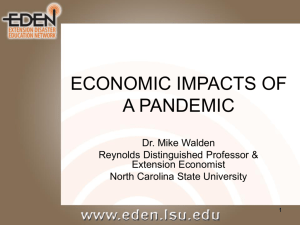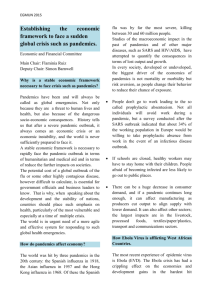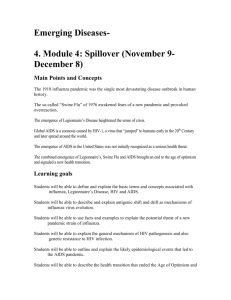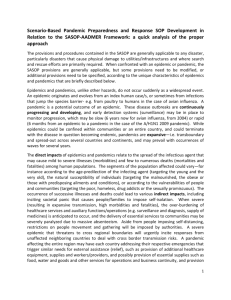Will the announced influenza pandemic really happen?
advertisement
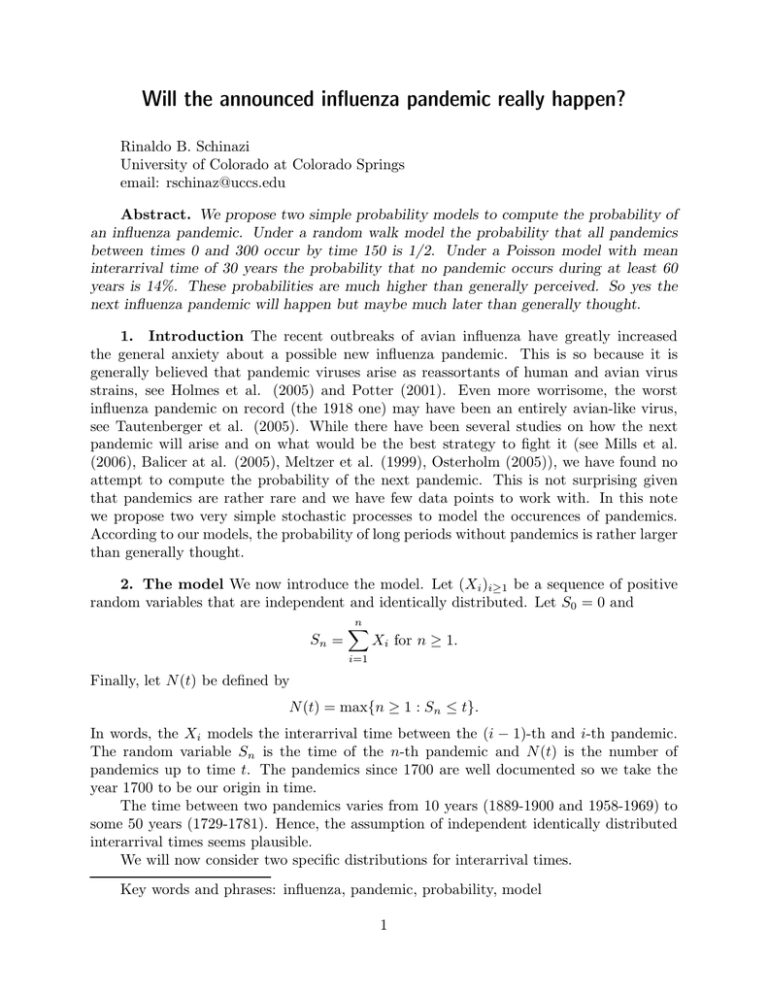
Will the announced influenza pandemic really happen?
Rinaldo B. Schinazi
University of Colorado at Colorado Springs
email: rschinaz@uccs.edu
Abstract. We propose two simple probability models to compute the probability of
an influenza pandemic. Under a random walk model the probability that all pandemics
between times 0 and 300 occur by time 150 is 1/2. Under a Poisson model with mean
interarrival time of 30 years the probability that no pandemic occurs during at least 60
years is 14%. These probabilities are much higher than generally perceived. So yes the
next influenza pandemic will happen but maybe much later than generally thought.
1. Introduction The recent outbreaks of avian influenza have greatly increased
the general anxiety about a possible new influenza pandemic. This is so because it is
generally believed that pandemic viruses arise as reassortants of human and avian virus
strains, see Holmes et al. (2005) and Potter (2001). Even more worrisome, the worst
influenza pandemic on record (the 1918 one) may have been an entirely avian-like virus,
see Tautenberger et al. (2005). While there have been several studies on how the next
pandemic will arise and on what would be the best strategy to fight it (see Mills et al.
(2006), Balicer at al. (2005), Meltzer et al. (1999), Osterholm (2005)), we have found no
attempt to compute the probability of the next pandemic. This is not surprising given
that pandemics are rather rare and we have few data points to work with. In this note
we propose two very simple stochastic processes to model the occurences of pandemics.
According to our models, the probability of long periods without pandemics is rather larger
than generally thought.
2. The model We now introduce the model. Let (Xi )i≥1 be a sequence of positive
random variables that are independent and identically distributed. Let S0 = 0 and
Sn =
n
X
Xi for n ≥ 1.
i=1
Finally, let N (t) be defined by
N (t) = max{n ≥ 1 : Sn ≤ t}.
In words, the Xi models the interarrival time between the (i − 1)-th and i-th pandemic.
The random variable Sn is the time of the n-th pandemic and N (t) is the number of
pandemics up to time t. The pandemics since 1700 are well documented so we take the
year 1700 to be our origin in time.
The time between two pandemics varies from 10 years (1889-1900 and 1958-1969) to
some 50 years (1729-1781). Hence, the assumption of independent identically distributed
interarrival times seems plausible.
We will now consider two specific distributions for interarrival times.
Key words and phrases: influenza, pandemic, probability, model
1
2.1 Poisson processes. We take as origin of time the year 1700. For a Poisson
process the interarrival times Xi are independent and exponentially distributed with rate
λ. That is,
P (X > x) = exp(−λx) for all x ≥ 0
and the mean time between two pandemics is 1/λ. Hence, the probability that the time
between two pandemics be at least twice the mean time 1/λ is
P (X > 2/λ) = exp(−2) ∼ 14%.
The probability that the time between two pandemics be at least three times the mean is
exp(−3) ∼ 5%.
Since 1700 there have been about 10 pandemics (the definition of pandemic is not
clear cut and experts seem to disagree on the status of a couple occurences, see Potter
(2001)). Hence, the average interarrival time for this small sample (n = 10) is 30 years (an
approximate 90% confidence interval for the mean interarrival time is (14,46)). If we use
λ = 1/30 the number of pandemics between times 0 and 300 is a poisson random variable
with mean 10. Figure 1 below shows the distribution of such a random variable.
0.14
0.12
0.1
0.08
0.06
0.04
0.02
0
−5
0
5
10
15
20
25
30
35
Figure 1. This is the distribution of the number of pandemics during a 300 years
period under the Poisson model with mean interarrival time of 30 years.
2
2.2 Random walk. Consider a simple symmetric random walk on the integers. If
the walker is at site i (where i can be a positive or negative integer) at time n (where n
is a positve integer) its position is represented by the coordinates (i, n). Flip a fair coin,
if it shows tails the walker jumps to (i + 1, n + 1), if it shows heads the walker jumps to
(i − 1, n + 1). Start the walk at (0, 0). Let the random variable Xj be the time of the
jth return to 0 for the first coordinate. The random variables Xj are independent and
identically distributed. This defines a discrete time renewal process and we think of each
return to 0 as being the occurence of a pandemic. In contrast to the Poisson process above
we have for this model that the mean of each Xj is infinite. This makes the prediction of
any given X very uncertain. More precisely, we have that
1
P (X > 2n) ∼ √ ,
nπ
see (2.4) and (3.1) in Chapter III in Feller (1968). Hence, the probability that the time
between two pandemics is at least 50 years is 11% but the probability that this time is at
least 100 years is 8%, not much less! Observe also that the mean number of pandemics
under this model is about 13 which is larger but still consistent with the 10 observed
pandemics since 1700.
0.05
0.045
0.04
0.035
0.03
0.025
0.02
0.015
0.01
0.005
0
−10
0
10
20
3
30
40
50
60
Figure 2. This is the distribution of the number of pandemics during a 300 units
period under the random walk model. This distribution can be computed exactly, see
Problem 10 in III. 10 in Feller (1968). Observe how spread out this distribution is.
30
25
20
15
10
5
0
−5
−10
0
50
100
150
200
250
300
350
Figure 3. This illustrates a ’typical’ path for a symmetric random walk over 300 time
units. In this case, there are 16 returns to 0 (corresponding to 16 pandemics). There
are no pandemics between times 144 and 300. In fact, the probability that all pandemics
between times 0 and 300 occur by time 150 is 1/2, see III.4 of Feller (1968).
3. Discussion As far as we can tell this is a first attempt to compute the probability
of an influenza pandemic. The occurence of a pandemic seems to be hopelessly complex
in the sense that it depends on a multitude of factors, some known others unknown.
Factors mentioned in the literature go from the stability of the current influenza strains
to the number of pigs in China! Hence, a model taking into account all known factors
would probably be as complex as the phenomenon itself, would not be that accurate and
would therefore be useless. Our approach is drastically different. We do not attempt to
incorporate into the model any of the factors that are believed to provoke a pandemic.
Instead we treat the occurence of a pandemic as a purely random phenomenon. Among
the many possible stochastic processes we picked two that are particularly random: a
4
Poisson process and a random walk. We believe they are good starting points because the
assumptions under which they are based are clearly stated and can be compared to the
data and discussed. Both models are so called renewal processes. The main difference is
that the time between two pandemics has a finite mean for a Poisson process but has an
infinite mean for the random walk model. The latter model is admittedly quite arbitrary
but it illustrates the fact that rather natural phenomena may give rise to infinite means
and hence wild fluctuations. With so few sample points it is of course difficult to assess
the goodness of fit of our models but at the very least they seem plausible.
Our main result is that, according to our models, there may be very long periods
without pandemics. Under the random walk model the probability, in any 2n years period,
that all pandemics will happen in the first n years is 50% (for any n). Under the Poisson
model with mean interarrival time of 30 years the probability that no pandemic occurs
during at least 60 years is 14%. These probabilities seem much higher than generally
perceived. Our main conclusion is that the next pandemic might not be as imminent as
generally thought.
References.
R.D.Balicer, M.Huerta, N. Davidovitch and I. Grotto (2005). Cost-benefit of stockpiling drugs for influenza pandemic. Emerging infectious diseases, 11, 1280-1282.
W. Feller (1968). An introduction to Probability Theory and its applications, Third
Edition, John Wiley and Sons.
E.C. Holmes, J.K. Tautenberger and B.T.Grenfell (2005). Heading off an influenza
pandemic. Science, 309, 989.
M.I.Meltzer, N.J.Cox and K.Fukuda (1999). The economic impact of pandemic influenza in the United States: priorities for intervention. Emerging infectious diseases, 5,
559-671.
C. E. Mills, J.M. Robins, C.T. Bergstrom and M. Lipsitch (2006). Pandemic influenza: risk of multiple introductions and the need to prepare for them. PLoS Medicine,
3, www.plosmedicine.org
M.T. Osterholm (2005). Preparing for the next pandemic. Foreign Affairs, JulyAugust 2005, http://www.foreignaffairs.org
C.W. Potter (2001). A history of influenza. Journal of applied Microbiology, 91,
572-579.
R.B.Schinazi (1999). Classical and spatial stochastic processes. Birkhauser.
J.K. Tautenberger, A.H. Reid, R.M. Lourens, R.Wang, G. Jin and T.G.Fanning
(2005). Characterization of the 1918 influenza virus polymerase genes. Nature, 473, 889893.
5
